 UPDATED - I have updated this article with a superb interview with Dr. Steven Jones that was taken from a superb new documentary on 9-11 entitled Loose Change 9-11: An American Coup. You can get the documentary from Netflix. The interview with Dr. Steven Jones is the first video below.
UPDATED - I have updated this article with a superb interview with Dr. Steven Jones that was taken from a superb new documentary on 9-11 entitled Loose Change 9-11: An American Coup. You can get the documentary from Netflix. The interview with Dr. Steven Jones is the first video below.The Open Chemical Physics Journal
Volume 2 , pp.7-31
ISSN: 1874-4125
Authors:
doi: 10.2174/1874412500902010007
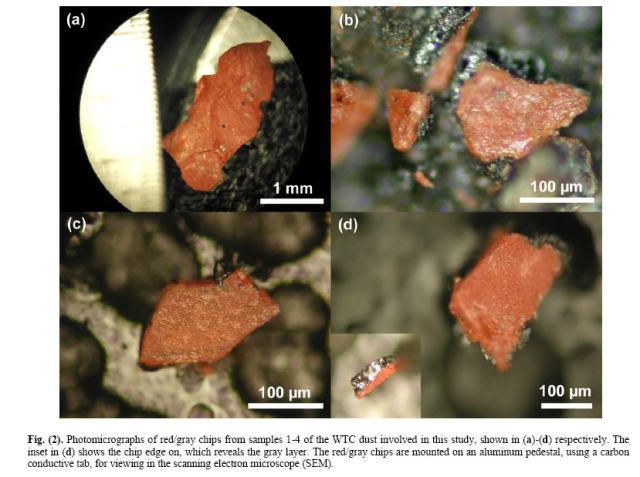
Abstract: We have discovered distinctive red/gray chips in all the samples we have studied of the dust produced by the destruction of the World Trade Center. Examination of four of these samples, collected from separate sites, is reported in this paper. These red/gray chips show marked similarities in all four samples. One sample was collected by a Manhattan resident about ten minutes after the collapse of the second WTC Tower, two the next day, and a fourth about a week later.
The properties of these chips were analyzed using optical microscopy, scanning electron microscopy (SEM), X-ray energy dispersive spectroscopy (XEDS), and differential scanning calorimetry (DSC). The red material contains grains approximately 100 nm across which are largely iron oxide, while aluminum is contained in tiny plate-like structures. Separation of components using methyl ethyl ketone demonstrated that elemental aluminum is present. The iron oxide and aluminum are intimately mixed in the red material. When ignited in a DSC device the chips exhibit large but narrow exotherms occurring at approximately 430 °C, far below the normal ignition temperature for conventional thermite. Numerous iron-rich spheres are clearly observed in the residue following the ignition of these peculiar red/gray chips. The red portion of these chips is found to be an unreacted thermitic material and highly energetic.
From Page 23 of the report:
Is the Red Material Thermitic in Nature?
Our observations show that the red material contains substantial amounts of aluminum, iron and oxygen, mixed together very finely. In the sample soaked in MEK, we observed a clear migration and aggregation of the aluminum away from other elements and determined that elemental aluminum and iron oxide must be present. In the product collected after DSC ignition, we found spheres which were not initially present. Many of these spheres were iron rich
and elemental iron was found in the post-ignition debris.
Further, the DSC traces demonstrate that the red/gray chips react vigorously at a temperature below the melting point of aluminum and below the ignition (oxidation) point of ultra fine grain (UFG) aluminum in air [18]. These observations reminded us of nano-thermite fabricated at the Lawrence Livermore National Laboratory and elsewhere; available papers describe this material as an intimate mixture of UFG aluminum and iron oxide in nano-thermite composites to form pyrotechnics or explosives [19-21]. The thermite reaction involves aluminum and a metal oxide, as in this typical reaction with iron oxide:
2Al + Fe2O3 -> Al2O3 + 2Fe (molten iron), /\H = -853.5 kJ/mole.
Commercially available thermite behaves as an incendiary when ignited [6], but when the ingredients are ultra-fine grain (UFG) and are intimately mixed, this “nano-thermite” reacts very rapidly, even explosively, and is sometimes referred to as “super-thermite” [20, 22].
We would like to make detailed comparisons of the red chips with known super-thermite composites, along with comparisons of the products following ignition, but there are many forms of this high-tech thermite, and this comparison must wait for a future study. Meanwhile, we compare with products of commercially available (macro-) thermite. During ignition of thermite, we have observed that many spheres and spheroids are formed as part of the molten product of the reaction is vigorously scattered. These particles tend to become spherical due to surface tension and, being small, are rapidly cooled and solidify as they fall through the air, thus
their spherical shape is preserved.
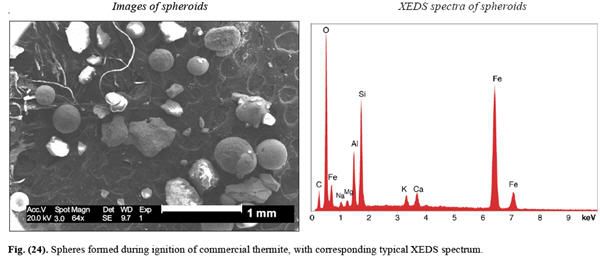
To facilitate comparisons between the products of red/gray chip ignition and commercial thermite ignition, we juxtapose the respective images and XEDS spectra. We observe that the spheroidal residues from ignition of red chips (Figs. 25, 26) possess a strikingly similar chemical signature to a typical XEDS spectrum from a spheroid generated by commercial thermite (Fig. 24). This similarity supports our hypothesis that the red chips are indeed a form of thermite.
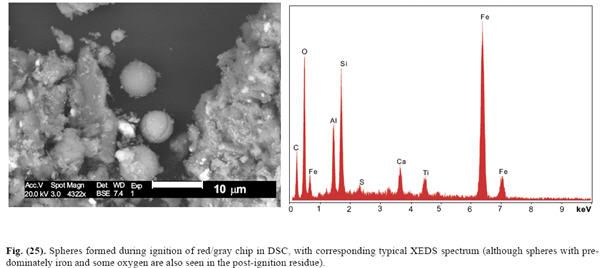
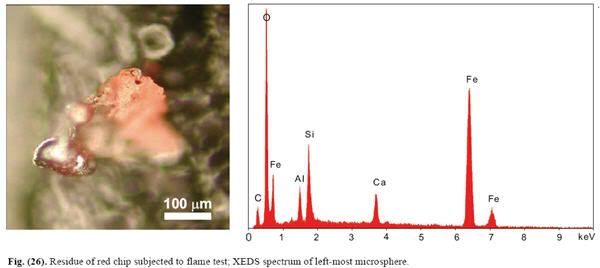
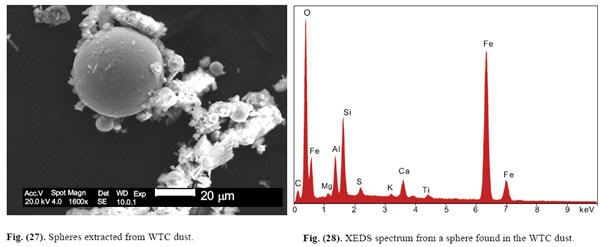
Download the Complete Study in PDF Here.
So now we have conclusive evidence of both unignited Thermite and the residue from Thermitic burning found in large enough amounts to have been found in multiple areas of Ground Zero. This adds to the amazingly cumulative evidence of the controlled demolition of WTC 1, 2, and 7. From 640+ Architects and Engineers who say that it is physically impossible, to the molten steel that was still molten weeks later and the fact that NIST, the government agency responsible for investigating the molten steel, was caught lying about its existence despite multiple MainStreamMedia and first responder accounts of its existence including both video, photographic, and even NASA satellite analysis of the heat it was giving off.
Other Evidence
The Top Ten Connections Between NIST and Nano-Thermites by Kevin Ryan
Who Put Super-Thermite in the Twin Towers? by Christopher Bollyn
The government and the MainStreamMedia
are Lying to the American People!
What are you going to do about it?
are Lying to the American People!
What are you going to do about it?

